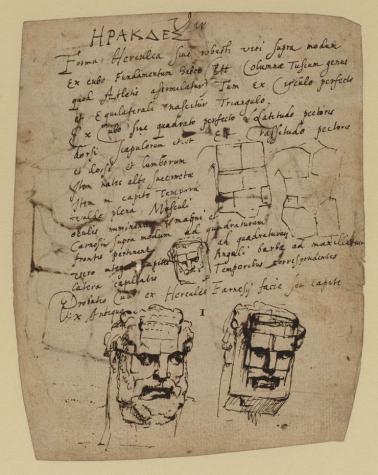
The Rubens House is showing the so-called de Ganay manuscript as a world premiere. The manuscript is one of four famous selective copies of the lost theoretical notebook of Peter Paul Rubens. The notebook unveils Rubens' vision and theoretical observations on the proportions of the human body, symmetry, perspective, anatomy and architecture. The Rubens House has also announced the restoration of the garden porch and the garden pavilion.
In 2012 the Rubens House received the de Ganay manuscript as a permanent loan from the King Baudouin Foundation. It is one of the four selective copies of the theoretical notebook that was kept by Rubens. The notebook unveils Rubens' vision and theoretical observations on the proportions of the human body, symmetry, perspective, anatomy and architecture.
THE LOST MANUSCRIPT
Rubens was not only a great artist but he was also an intriguing theorist. Presumably between 1600 and 1615 he wrote down his art theoretical views in a notebook. The manuscript contains sketches, drawings, notes and text fragments in different languages and it gives the reader an insight in Rubens' visions on optics, symmetry, proportions, anatomy and architecture and his study of the most important human feelings. After some wandering, the document came into the hands of André-Charles Boulle, the French royal cabinet maker of Louis XIV. In 1720, the manuscript was destroyed as a result of a fire in his workshop. The theoretical notebook was lost forever, except for one or two pages that are preserved in London and Berlin.
Until 19 January 2014 the Rubens House is showing four selective copies of this theoretical notebook. Two of them were copied during Rubens' life. To these copies apocryphal material was added. The first one, the Chatsworth manuscript, was executed by a brilliant copier, presumably Anthony Van Dyck. The second one, the Bordes manuscript was the basis for the two subsequent copies: the Johnson and the de Ganay manuscript. Current research has revealed that the Bordes manuscript also contains a number of original Rubens drawings.
The de Ganay manuscript was probably executed shortly after Rubens' death by someone from his close circle of friends and it might well have been the preliminary work for a publication. In January 2012 the King Baudouin Foundation purchased the de Ganay manuscript and donated it to the Rubens House as a permanent loan. The actual exhibition in the Rubens House presents the first public showing of this acquisition to the general public.
THE SEARCH FOR A LOST DOCUMENT
The four selective copies introduce the visitor in Rubens' surprising ideas. Each manuscript has its own characteristics, and by comparing the four, it is possible to get an idea of what the original notebook must have looked like.
For the very first time, the four copies have been studied as a whole. The new volume of the Corpus Rubenianum is entirely devoted to this research. Arnout Balis (Centrum Rubenianum vzw) will publish the results of the scientific research in the spring of 2014.
RESTORATION OF THE GARDEN PORCH AND PAVILION
The Rubens House has also announced the commencement in 2016 of the restoration of the garden porch and the garden pavilion.
In 1610 Rubens bought a house with land on the Wapper in Antwerp. During the following years he would expand his property according to his own designs with a covered, half-round picture gallery, a studio, a triumphal arch like porch and a garden pavilion. The porch closed off the inner courtyard by connecting the old sixteenth-century house with the new painter's studio (the schilderhuys) which Rubens designed in the style of an Italian palazzo. From Rubens' original design only two elements have survived largely intact: the porch which constitutes the impressive entrance to the garden, and the garden pavilion which can be seen through the central arch as an eye-catcher whereby Rubens aimed at a sensational garden perspective.
Through the combination of unusual architectonic patterns that derived directly form Italy and the rich decoration with sculptures and sculptured ornaments this porch probably is the most ingenious example of civilian architecture that has been preserved north of the Alps.
The Antwerp city council has included both restorations projects in its multiannual planning.
Rubens: maverick artist. The master's theoretical notebook
Until 19 January
The Rubens House
Wapper 9-11
Antwerp
More info
